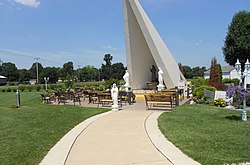| St. Padre Pio Shrine | |
|---|---|
 | |
 | |
| 39°32′1″N74°56′51″W / 39.53361°N 74.94750°W | |
| Location | P.O. Box 203, Harding Highway, Landisville, N.J., 08326 Corner of Harding Highway (Route 40), Central Avenue and Weymouth Road (County Road 690) in Landisville, NJ |
| Country | United States |
| Denomination | Roman Catholicism |
| Tradition | Folk Catholicism |
| Weekly attendance | 300 (Wednesday 7:00 PM) |
| Website | www |
| History | |
| Status | Shrine |
| Founded | 1997 |
| Founder(s) | Marie and Pete D'Andrea |
| Relics held | Glove of St. Padre Pio |
| Architecture | |
| Architect(s) | Ron Angelo |
| Architectural type | Vernacular |
| Completed | 2002 |
| Specifications | |
| Height | 4 stories |
| Floor area | 10 acres (outdoor) |
| Materials | Stucco with steel frame |
The St. Padre Pio Shrine is an outdoor Roman Catholic shrine in the Landisville section of Buena, New Jersey dedicated to the 20th-century Italian saint Padre Pio and completed in 2002. [1]
